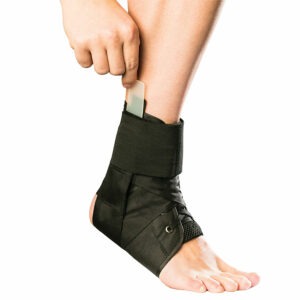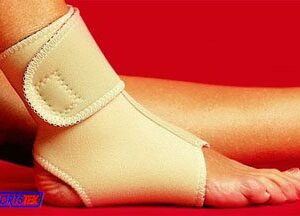Diagnostic Guide – Ankle Pain
Updated:
Patients suffering from ankle pain are commonly seen in physiotherapy practice. Pain is usually caused by local structures within or around the ankle, however, in rare cases, pain may be referred from other sources (such as the lower back).
The most common mechanism of injury in patients suffering from sudden onset ankle pain is a ‘rolled ankle’. This is typically due to an inversion movement whereby the foot and ankle turn inwards relative to the lower leg (figure 1). In these instances, damage to the lateral ligament of the ankle (figure 2) most commonly occurs (Sprained Ankle (Lateral Ligament). However, other structures may also be involved, such as the shock absorbing cartilage within the ankle joint, peroneal muscles or local bones (i.e. a fracture) (figure 3).
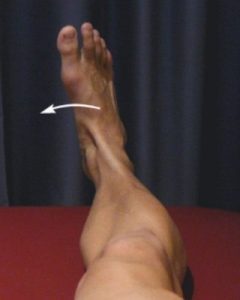
Figure 1 – Ankle Inversion

Figure 2 – Ankle Pain Anatomy
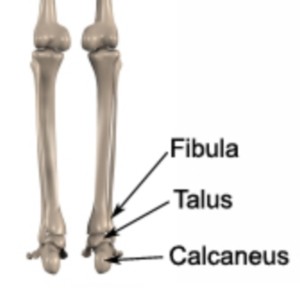
Figure 3 – Bones of the Ankle
Gradual onset ankle pain often occurs in those patients involved in sports or activities that involve excessive walking or high running loads (particularly with rapid changes of direction, on uneven surfaces or in inappropriate footwear). In these cases, overuse injuries to the tendons around the ankle are common. One of the most common causes of gradual onset pain located at the front of the ankle is Tibialis Anterior Tendonitis . Patients with gradual onset pain located at the outer aspect of the ankle are often due to Peroneal Tendonitis, whilst those suffering from gradual onset pain located at the inner aspect of the ankle are often due to Tibialis Posterior Tendonitis. Patients with gradual onset pain located at the back of the ankle are often due to Achilles Tendonitis (please refer to the Achilles & Heel Diagnostic Guide). In older patients with gradual onset ankle pain, the most likely cause of symptoms may be degenerative changes in the ankle, such as Ankle Arthritis.
There are numerous other causes of ankle pain, some of which present suddenly due to a specific incident, others which develop gradually over time.
Below are some of the more common causes of pain in the ankle region with a brief description of each condition to aid diagnosis.
Conditions have been organised according to sudden or gradual onset and common or less common conditions for ease of use.
Find out what may be causing your ankle pain:
Sudden Onset Ankle Pain – Common Injuries
Lateral Ligament Sprain
Tearing of the lateral ligament of the ankle (figure 2) typically following a rolled ankle (inversion Injury – figure 1). Associated with outer ankle pain, pain on firmly touching the lateral ligament of the ankle (figure 2), pain on turning the foot and ankle inwards excessively (inversion – figure 1) and often swelling or bruising. Arguably the most common cause of acute outer ankle pain.
Osteochondral Lesion of the Talar Dome
Damage to cartilage or bone located at the top of the talus bone (figure 3), usually due to compressive forces such as a landing from a jump and often in association with a rolled ankle. Symptoms may increase during weight bearing activities such as excessive walking or running (especially up hills or on uneven surfaces) or during hopping or jumping. Pain may also increase on firmly touching the region of the talus bone, often at the front of the ankle (figure 4).

Medial Ligament Sprain
Tearing of the medial ligament of the ankle (figure 6) typically following a rolled ankle (eversion Injury – figure 5). Associated with inner ankle pain, pain on firmly touching the medial ligament of the ankle (figure 6), pain on turning the foot and ankle outwards excessively (eversion – figure 5) and often swelling or bruising.
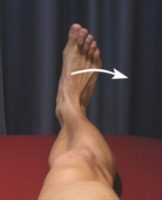
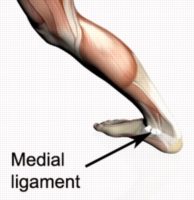
Less Common Sudden Onset Injuries
Distal Tibiofibular Joint Injury
Tearing of connective tissue holding the tibia and fibula bones together just above the ankle, typically in association with more severe ankle injuries. Often associated with significant pain usually at the front of the ankle, reduced function and tenderness on firmly touching the affected region (figure 7).
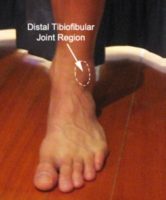
Lateral Malleolus Fracture
Fracture of the bony process at the outer aspect of the ankle usually due to traumatic forces (e.g. landing from a height) often in association with a rolled ankle. Associated with significant outer ankle pain (particularly during weight bearing), swelling and tenderness on firmly touching the affected region of the bone (Figure 8 – Lateral Malleolus).
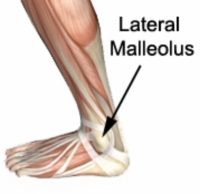
Medial Malleolus Fracture
Fracture of the bony process at the inner aspect of the ankle usually due to traumatic forces (e.g. landing from a height) often in association with a rolled ankle. Associated with severe inner ankle pain (particularly during weight bearing), swelling and tenderness on firmly touching the affected region of the bone (figure 9).
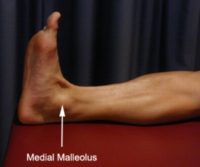
Talus Fracture
Fracture of the talus bone (figure 3) usually due to traumatic forces (e.g. landing from a height) and associated with severe pain often at the front or sides of the ankle (particularly during weight bearing) and swelling. Pain may also increase on firmly touching the talus bone, often at the front of the ankle (figure 4).
Pott’s Fracture
Fracture of one or more bony processes located at the sides of the ankle (e.g. the medial and lateral malleolus – figures 8 & 9) usually due to traumatic forces such as landing from a height or in association with a severe ankle sprain. Associated with severe pain (particularly during weight bearing), swelling, sometimes deformity and tenderness on firmly touching the affected region of bone (figures 8 & 9).
Dislocated Ankle
Separation of the ankle joint due to traumatic forces (e.g. motor vehicle accident / fall from a height) with severe pain, loss of function, swelling, deformity and often associated with one or more fractures.
Peroneal Tendon Subluxation
Movement of the peroneal tendon (figure 10) out of its normal position causing a sensation of the tendon flicking in and out of position at the outer aspect of the ankle (over the lateral malleolus – figure 8) during certain movements. Associated with pain or ache located at the outer aspect of the ankle often with swelling, bruising and tenderness on firmly touching the peroneal tendon (figure 10).
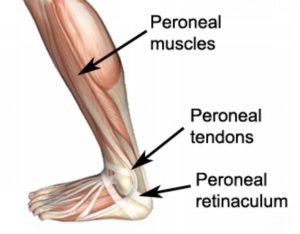
Peroneal Tendon Rupture
Rupture of one or more peroneal tendons (figure 10) associated with sudden onset pain in the outer aspect of the ankle usually due to a specific incident followed immediately with loss of function and significant weakness on attempted ankle eversion (figure 5). A snap or tear may be audible during injury. Swelling, bruising and tenderness on touching the tendon is typically present (figure 10).
Tibialis Posterior Tendon Dislocation
Movement of the tibialis posterior tendon (figure 11) out of its normal position causing a sensation of the tendon flicking in and out of position at the inner aspect of the ankle (over the medial malleolus – figure 9) during certain movements. Associated with pain or ache located at the inner aspect of the ankle often with swelling, bruising and tenderness on firmly touching the tibialis posterior tendon (figure 11).
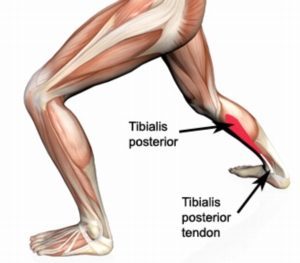
Tibialis Posterior Tendon Rupture
Rupture of the tibialis posterior tendon (figure 11) associated with sudden onset pain in the inner aspect of the ankle usually due to a specific incident, followed immediately with marked loss of function, weakness on attempting a heel raise (figure 12) and later an observable drop in height of the inner arch of the foot during weight bearing. A snap or tear may be audible during injury. Swelling, bruising and tenderness on firmly touching the tendon (figure 11) is typically present.
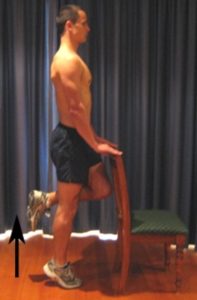
Gradual Onset Ankle Pain – Common Injuries

Members Only ContentBecome a PhysioAdvisor Member to gain full access to this exclusive content. For more details see Become a Member. Already a member? Login Now
Less Common Gradual Onset Injuries

Members Only ContentBecome a PhysioAdvisor Member to gain full access to this exclusive content. For more details see Become a Member. Already a member? Login Now
Diagnosis of ankle pain
A thorough subjective and objective examination from a physiotherapist is usually sufficient to diagnose the cause of ankle pain. Investigations such as an X-ray, ultrasound, MRI, CT scan or bone scan are often required to confirm diagnosis and rule out other injuries (particularly fractures).
 Find a Physio for ankle pain
Find a Physio for ankle pain
Find a physiotherapist in your local area who can diagnose and treat patients suffering from ankle pain.
 More Information
More Information
- View Ankle Stretches
- View Ankle Strengthening Exercises
- View Balance Exercises
- View detailed information on initial injury management and the R.I.C.E Regime
- View detailed information on How to use Crutches
- View detailed information on when to use Ice or Heat
- View detailed information on Do I Need Orthotics?
- View a Return to Running Program
 Physiotherapy products for ankle pain
Physiotherapy products for ankle pain
Some of the most commonly recommended products by physiotherapist for patients with ankle pain include:
To purchase physiotherapy products to assist with ankle rehabilitation click on one of the above links or visit the PhysioAdvisor Shop.

Link to this Page
If you would like to link to this article on your website, simply copy the code below and add it to your page:
<a href="https://physioadvisor.com.au/injuries/ankle”>Diagnostic Guide – Ankle Pain – PhysioAdvisor.com</a><br/>PhysioAdvisor offers a detailed ankle diagnosis guide created by experienced physiotherapists. Find out what's causing your ankle pain.
Return to the top of Diagnostic Guide – Ankle Pain.


